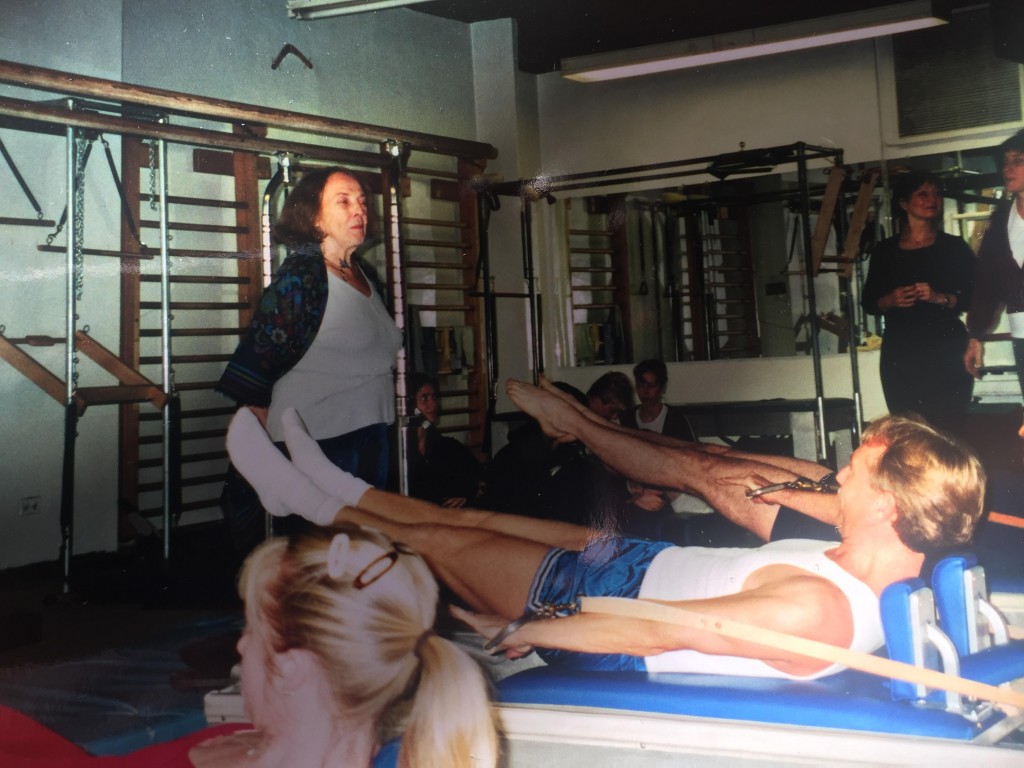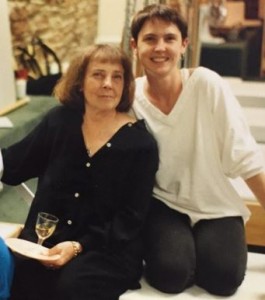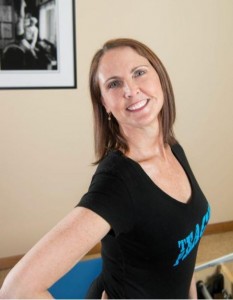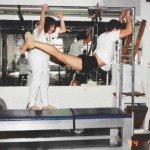Romana Kryzanowska’s Place in the History of Pilates
By Amy Taylor Alpers
May 23, 2017
I wrote a piece for PilatesIntel awhile back in which I told Romana’s history and tried my best to describe her character and vivacious, fun-loving nature. Give her a glass of champagne, take her dancing, and she’d shine at her brightest. Be her devoted student, and she’d give you everything. However, there is still confusion about Romana’s place in the larger history of the Pilates industry and I’d like to offer my thoughts on this topic.
As a classical ballet dancer, Romana was a devotee of the power and necessity of form. The design and order of a classical ballet class has changed very little in the last few centuries. Once it was fully codified, every ballet dancer, for hundreds of years, has placed one hand on the barre and begun class or warm-up with plies, followed by tendus, then dégagés , then ronds de jamb, etc. After barre, you move to the center of the floor and continue class in a set and orderly fashion, from adagio, to turns, to jumps, to big combinations of classical vocabulary done moving across the floor, and then ending with a reverence. There are slight variations on this theme, of course, but a commitment to this form, honed and refined over many years, is what has produced amazing ballet dancers as far back as you can remember.
Modern dance was created from a need to react to the strictness of this form. And with all reactions, there was a phase of chaos – anything goes – until its own forms emerged as well. Still, modern dance is founded on the idea of the individual’s voice and unique movement style. From Loie Fuller and Isadora Duncan, to Martha Graham, Merce Cunningham, and many, many more, each had their own beliefs about movement, and choreographed to that inner personal drive to express themselves in a new and unique way. This is how modern dance set itself apart from classical ballet. However, soon enough, modern dancers began to return to the classical ballet form to refine their actual technique.

Romana teaching where Bob Liekens is a student.
This is over-simplified, of course, but I hope, for this discussion anyway, it will serve its purpose. Modern dancers are often, by nature, interested in their own way of moving – and in creating their own form. Becoming choreographers, in fact. This was clearly true for Ron Fletcher, Kathy Grant, Eve Gentry, and even Carola Trier. Classical ballet dancers, on the contrary, are almost solely committed to learning and continually exploring how to use an already existing form to develop their technique and bodies. Very few become choreographers.
This is how I hold Romana’s place in the history of the Pilates method. She was the lone classical dancer of the five. All the rest were modern or theatrical dancers who choreographed their own pieces. A choreographer cannot help but create new movement. It is their very nature. A classical ballet dancer will typically not create new moves but continue to explore the depths of the techniques’ vocabulary – the perfection of a plie, for instance – for their entire career.
I had the personal pleasure and honor to meet and speak with both Kathy Grant and Ron Fletcher on several occasions over the years. I can state unequivocally, that both were extremely adamant that anyone who learned from them be very clear about the difference between what was something Mr. Pilates had created, and what was of their own design. They were fiercely exacting on this point. And I have heard from other key sources that Carola Trier and Eve Gentry were just as steadfast about this issue. They were proud and honorable people who gave credit where credit was due.
When Kathy Grant walked into my studio in Colorado and saw all our space and equipment, she said to me, “Honey, if I’d had your studio, I would have taught Pilates too!” What she meant was, she hadn’t had the luxury of the generous space and amount of equipment we did, and had had to be creative with movement due to her circumstances. Alternately, she taught very large classes of dancers without equipment and felt she needed to develop movements that would enable precision and control when she couldn’t be right over someone, watching with her usual detail. When several of her students said they wanted to become Pilates teachers, she very pointedly sent them to Romana and to us. She told me she said to them that she didn’t teach people how to teach Pilates, Romana did. She was very clear about this.
Ron told me he created some of his exercises because of circumstances as well. For instance, he had a group of wealthy female clients whom he referred to as the “ladies who lunch.” They would bring him to Vail, CO annually to teach them. There wasn’t always equipment and he had hours to fill. For example, he told me that one day he simply picked up a towel and began to develop his towel work. This is how it happens. Circumstances require creativity. Necessity is the mother of invention. And creative choreographers create new movements.
 It’s only in the years since they have all passed, and because of the loss of the trademark for the word Pilates, that later generations have muddied these truths. There is even a movement afoot in the industry to rename “Classical Pilates” to “Romana’s Pilates” to equalize it with the other “lineages.” However, in my humble opinion, this is wrong.
It’s only in the years since they have all passed, and because of the loss of the trademark for the word Pilates, that later generations have muddied these truths. There is even a movement afoot in the industry to rename “Classical Pilates” to “Romana’s Pilates” to equalize it with the other “lineages.” However, in my humble opinion, this is wrong.
Romana Kryzanowska devoted her life and career to carrying the torch of Joseph Pilates’ method as he created it, as truly and honestly as she could. Did she change things? Yes. But by any one’s standards in the Pilates industry, she changed it VERY VERY little compared to others, and probably mostly unintentionally. (She couldn’t help adding some balletic flair because she so deeply loved classical dance. And the discussion of the importance of transitions to the classical work, as something Romana instituted, is something I will discuss in my next article.) She truly tried to stay true to his work as best she could. She was very committed to that. She would say, “I am not a genius. He was. I just try to teach what he taught me.”
 Amy Taylor Alpers co-founded The Pilates Center (TPC) and The Pilates Center Teacher Training Program (TPCTTP) over 20 years ago in Boulder, Colorado. When not traveling the world to teach both foundational and graduate level Pilates teacher education she remains part of the core faculty for TPCTTP, mentors advanced teachers, teaches classes and sees clients. In addition to teaching TPC sponsored workshops, Amy has presented numerous times at the Pilates Method Alliance Annual Meeting, Balanced Body’s Pilates on Tour and Passing the Torch. In 2013, Amy presented at the Shared Traditions Conference for Fletcher Pilates and will present at The Pilates Roundtable.
Amy Taylor Alpers co-founded The Pilates Center (TPC) and The Pilates Center Teacher Training Program (TPCTTP) over 20 years ago in Boulder, Colorado. When not traveling the world to teach both foundational and graduate level Pilates teacher education she remains part of the core faculty for TPCTTP, mentors advanced teachers, teaches classes and sees clients. In addition to teaching TPC sponsored workshops, Amy has presented numerous times at the Pilates Method Alliance Annual Meeting, Balanced Body’s Pilates on Tour and Passing the Torch. In 2013, Amy presented at the Shared Traditions Conference for Fletcher Pilates and will present at The Pilates Roundtable.
Amy was born in Youngstown, Ohio where she began classical ballet at age two.
She attended The Juilliard School for Dance, danced with the Garden State Ballet in New Jersey, and received a B.A. in Dance and a M.A. in Dance History from New York University. In addition, Amy taught ballet at various dance schools in New York City for ten years before launching her Pilates career.
Both Amy and her sister Rachel studied Pilates under the direct tutelage of Romana Kryzanowska at the original Pilates Studio in New York City. They received their Pilates teaching certificate from there in July of 1989. In 1990, after moving to Boulder, Colorado, Amy and Rachel founded The Pilates Center. The sisters then created and established The Pilates Center Teacher Training Program in 1991. The school has since expanded to include an Intermediate Program, Advanced Program, Bridge Program, Master’s Program, and a Mentorship Program. In addition, TPC now has “Licensed” and “Host” studios established all around the world.
Amy and her sister wrote The Everything Pilates Book, published in 2002. She was a founding board member of the PMA and sat on the board that created the PMA Certification Exam. Recently she has also had the honor of filming classes and workshops for online organizations such as Pilates Anytime and Pilates On Demand.
In 2011, Amy, her sister Rachel, and Ken Endelman of Balanced Body, developed CenterLine – a line of equipment designed for classical Pilates and based upon the specifications pioneered by Joseph Pilates.

